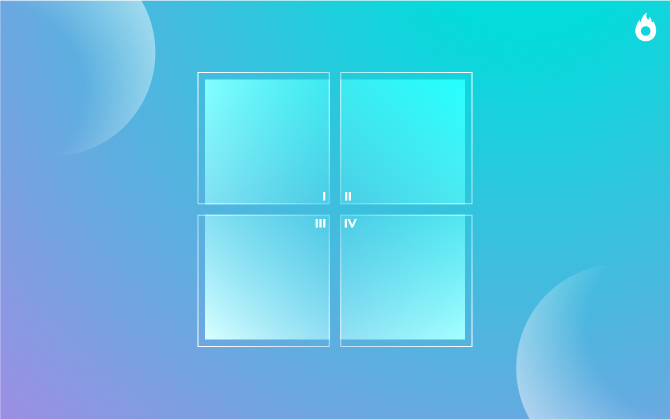
Building feedback with the Johari Window
The Johari Window is one of the main tools for working with feedback. See how it works and how to receive constructive criticism!

Receiving feedback and evolving from it is essential if you want to achieve success, but giving and receiving feedback is not easy. So, it’s a good idea to rely on tools that optimize this process, such as the Johari window.
Effective communication is a must-have for all teams. Part of this process requires understanding how interpersonal relationships help in this context, as well as receiving feedback, which is so important for personal and professional growth.
Have you heard about this model? In this post, we’ll explain what the Johari window is and how it can help you with feedback. Keep reading!
What is the Johari window?
The Johari window tool was created in 1955 for self-knowledge and improving interpersonal relationships.
Developed by American psychologists Joseph Luft and Harrington Ingham, in Chicago, this technique (which gets its name Johari from the combination of the researchers’ initials) is an instrument for analyzing behavior and characteristics indicated by different points of view.
The model was created based on a group activity developed at the University of California and later refined by Joseph Luft.
This tool demonstrates a self-awareness analysis while also showing the perception of others about the individual.
It’s a window into personal development, skill development, better communication, and team connection. With this model, you’ll have a more objective and detailed overview of behaviors, qualities, and opportunities for improvement.
Effective in many situations, the Johari Window can be developed between two people or even in groups, and thus, can help with big changes both on a personal and professional level.
In this article, we’re going to explain what this model is all about and how you can apply it to yourself and your team.
How does the Johari Window work?
The main Johari Window features are based on quadrants and axes that guide the “self” of the individual. It’s through them that you’ll unravel more detailed and relevant information to improve the self-knowledge process.
You and your group will have to list positive and negative characteristics in each of these boxes based on their positive and negative aspects.
Below, you’ll learn more about these quadrants and the 4 “selves”, which are so important for this tool to work. Are you ready?!
The Johari Window Quadrants
The Johari Window consists of four quadrants that are divided into two axes. Each quadrant gathers information at different points of knowledge about a person.
This information can be internal (that the person him/herself knows) and external (that other people have indicated). The axes are divided into horizontal and vertical.
The horizontal axis represents what is known and unknown by the individual. On it we have the open zone (characteristics that the individual and others know) and the blind zone (characteristics that only the individual does not know).
The vertical axis represents the knowledge that other people have or do not have about the individual. This axis includes the open zone and the hidden zone (characteristics that only the individual him/herself knows).
The unknown zone, as the name implies, is unknown to everyone and symbolizes new discoveries. We will talk more about this later.
The Johari Window panes
To better understand the Johari Window quadrants, it’s important to know each “self” that will be worked on in this method. In each one, it will be necessary to understand information about yourself, from you and from other people.
Open self: The open self is everything that you expose to the world about yourself. It’s how you communicate and the characteristics that you’re most comfortable exposing. Other people recognize this information, and so do you.
It is a shared vision of qualities and flaws that are easily identified by everyone in everyday life. This is the first “layer”, with everything that you don’t hide and know completely.
- Blind self: The blind self is everything that is part of you, but that only others can see. Up to this point, these aspects come from unconscious actions and expressions.
These are characteristics (qualities and flaws) that you haven’t recognized yet. This is where other people’s judgments and interpretations about you come in, based on how you express yourself verbally and non-verbally, how you act, and how you communicate.
Based on our relationships and interactions, our behavior is also analyzed, and this is where personality traits emerge, and that are not picked up by the person themselves, only by those observing from the outside.
Knowing what’s within the “blind self” is a gateway to improving aspects and having control over them.
- Hidden Self: The hidden self gathers the personal characteristics that you don’t reveal to others. These are points that for some reason are hidden or not communicated, and only you are aware of them.
This self usually harbors everything that the person represses for fear of the judgments of others and everyday insecurities. Many flaws are hidden here, and this hiding place can end up creating false impressions or harming relationships.
Certain skills might also be included in this area, which hinders improvement, and personal and professional satisfaction.
- Unknown Self: The “self” that neither you nor others know about yet, and it can harbor characteristics that already exist and are not recognized, or that will appear in the future.
This “self” appears empty to represent everything that can still be discovered about oneself. When the individual becomes aware of a new aspect, he or she enters the hidden or blind zone and can later become part of the open zone.
To better explore the unknown self, it’s necessary to work on other methodologies with professionals that help in this process.

Using the Johari window model
The application of the Johari window is based on an assumption of honesty. In other words, it’s essential that you be devoid of any form of judgment or subjective interpretation, in addition to avoiding being upset by the responses obtained through the group’s perception.
Self-awareness is also based on the acceptance of the perception others have about you. Therefore, filling out the Johari window is a great way to evaluate the image we project to others.
A good way of filling out the Window is by using a list of attributes. These attributes can be divided into those that are positive, considered as virtues, and those that are negative, considered as defects – or euphemistically speaking, points of improvement.
Your self-image
The first step is finding out what image you have of yourself. To do so, list the characteristics you know you have (or think you have).
Devoid of prejudgments, observe the qualities and flaws that best define your personality.
To facilitate the analysis procedure, limit your choices to 10 virtues and 10 flaws, trying to pick those that best represent your personality.
Your image to others
After your self-analysis, it’s time for the most delicate step.
Within your social group (personal or professional, depending on the objective of applying the tool), select about 5 people who are closer to you. It’s important that you trust these individuals and that they know you well.
Next, if you’re using the list of virtues and flaws, hand a copy to each of them and ask them to perform the same procedure you did in the first step, marking the characteristics that best represent your personality.
Remember to tell them that the answers are anonymous and must be limited to 10 positive and 10 negative points.
If applicable, seal the answers in an envelope so that people feel more at ease about answering as honestly as possible.
Comparing answers
After collecting the impressions of those close to you, it’s time to compare each answer with your own.
If you want to, insert the characteristics in a table to facilitate the tally.
The points in common between your answers and the answers of others will be part of the “open self”.
What others have pointed out and you haven’t, will be part of your “blind self”.
The characteristics that you have marked and that no one else marked are part of your “hidden self”.
Your “unknown self” as you must have imagined, is not known, and can be analyzed by other tools.
How the Johari window helps you in the self-awareness process
After building your Johari window, it’s time to analyze the chart.
The “open self” area is everything that is public about your personality. It consists of the characteristics that are known to you and to others.
The “blind self” represents the characteristics that are unknown to you but are known by others, albeit unintentionally revealed by you. It corresponds to what you do unknowingly or unconsciously.
This is perhaps one of the main points to be analyzed as feedback based on the Johari window, because the “blind self” is perceived by how you speak, how you express yourself verbally and non-verbally, how you communicate and react in different situations.
On the other hand, the “hidden self” corresponds to characteristics that you don’t want others to know, and in fact, remain secret. It can remain secret for fear of judgment and negative reactions, or simply because we cannot reveal such characteristics in a clear and objective manner.
It may also represent an incongruity of perceptions, as in people who view themselves as liberal but actually have conservative and stable attitudes.
Finally, the “unknown self” corresponds to the areas that still haven’t been explored.
Although the Johari window isn’t exactly the best tool to analyze this area, you can search among the characteristics that were pointed out neither by you nor by the others, and try to find which virtues you can improve.
Ideally, you should seek specialized supervision to get in touch with your “unknown self”.
The Johari window and feedback
The application of the Johari window is, by itself, a great way of analyzing feedback. However, you can also ask several questions with the tool, such as:
- What are the characteristics of each “self” in your window?
- What image do you project that you’d like to change?
- What would you like to project to others and isn’t being perceived?
- How can you change the image others have of you?
The Johari window is a great tool to analyze how you perceive yourself and what image that people in your social or professional circle have of you. With it, we can motivate ourselves to pursue changes, always seeking continuous improvement.
This post was originally written in April 2019 and has since been updated to contain additional and more accurate information.





